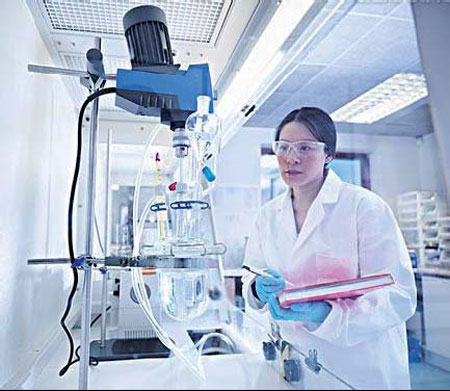The need for speed
Updated: 2013-01-25 09:35
By Zhong Nan (China Daily)
|
|||||||||||
|
China lags behind Western countries in terms of being able to provide innovative drugs for patients. Provided to China Daily |

Pharmaceutical companies in china appeal for faster reviews
The R&D-based Pharmaceutical Association Committee, an organization that represents 39 foreign companies, is appealing to the Chinese government to speed up its drug review system to boost pharmaceutical innovation.
China lags behind Western countries by four to eight years in terms of being able to provide innovative drugs for patients, caused by the low capacity of its review body and lengthy review procedure, according to a report by RDPAC.
Under the China Association of Enterprises with Foreign Investment, RDPAC expects China to increase investment on drug evaluation resources as quickly as possible, which could benefit its huge population and speed up its industrial development.
Zhuo Yongqing, president of RDPAC, says many of the organization's members - including US-based Pfizer Inc and Denmark's Novo Nordisk AS - will launch new drugs in the US and European markets this year, but they know that these drugs will not be approved in China until 2016.
"Even though China's 12th Five-Year Plan (2011-15) aims to improve the innovative capacity of the Chinese pharmaceutical industry, there are still some key bottlenecks that need to be eliminated," he says.
"Drug research and development is out of the question without a clinical trial. The review process for starting clinical trials, a big step before a new product enters the market, can take as long as 10 to 18 months in China, compared with four months in India and only one or two months in the US, Europe and Japan."
Because of this relatively slow pace, it is difficult for many international clinical trials to be started in China. Some domestic pharmaceutical enterprises even hold their clinical tests in other countries such as the Netherlands, France and South Korea to speed up progress.
The root of this phenomenon lies in the serious shortage of Chinese drug-evaluation registered resources - in the entire country, there are only about 120 people engaged in drug registration. However, new drug applications grew by 14 percent each year since 2008, RDPAC reported.
In contrast with the review authority in China, more than 2,000 people in the US Food and Drug Administration and more than 500 in the European Union are responsible for the same work.
In 2012, RDPAC members increased their investments in R&D innovation in China to 8 billion yuan ($1.29 billion; 962 million euros), which accounted for more than half of the total R&D expenditure of all mid- and large-size pharmaceutical enterprises in China and created around 3,000 high-end research jobs.
These companies have introduced more than 67 innovative drugs to the Chinese market in the past five years, accounting for 80 percent of all original drugs available in the market at that time.
Chen Qiyu, chairman of Shanghai Fosun Pharmaceutical (Group) Co, says China's pharmaceutical industry has been focusing on generic drugs for more than a decade, therefore the existing review system for innovative drugs is still an element that can hinder future innovation in this sector.
Generic drugs are comparable to original drugs in terms of dosage, strength, quality and performance characteristics as well as intended use. They can be marketed after the patent for the original drug expires, thus the prices of generics are much lower than the original medication.
"Biomedicine has already entered the phase of mass production and innovation in the US and European markets, and the world's major drug producers have all stressed this would be the future trend for the pharmaceutical industry," Chen says.
"Thus, a reform of China's drug review system is urgently needed to catch up with other countries. It would bring substantial benefit to domestic drug makers to produce more biomedicine that can be made in China, as well as to Chinese patients."
In terms of entering the overseas markets, Chinese drug makers must undertake the review process all over again, even if they have already performed reviews in China. The advantage of following international norms is that domestic companies only need to do the review once, which could prevent financial loss and save a lot of time.
Sang Guowei, vice-chairman of the Standing Committee of China's National People's Congress, urges that any reform of the drug review process should be in line with international standards.
"China is a facing rare opportunity to build a brand-new industrial ecosystem, catch up with and surpass the Western countries and achieve 'leapfrogging' development. Since China has a relatively short history of modern pharmaceutical R&D, there are not so many obstacles left," Sang says.
"Of course, it can avoid those detours taken by the West and leverage the best practices in the world to establish an industrial system with Chinese characteristics."
However, it will be a demanding, long-term job to transform the industry. China has more than 6,300 drug manufacturers, about 85 percent of which still carry out generic drug production and only invest a small amount in innovation.
To change the situation, the Chinese government has been optimizing its industrial resources and raising financial support to quickly upgrade the nation's pharmaceutical industry from emulation to innovation.
It plans to allocate 31.6 billion yuan to encourage major drug innovation and technical upgrades from 2008 to 2020. The fund grew by 42 percent from 2011 to 1.8 billion yuan in 2012, according to China's State Food and Drug Administration.
zhongnan@chinadaily.com.cn
(China Daily 01/25/2013 page13)
Today's Top News
Police continue manhunt for 2nd bombing suspect
H7N9 flu transmission studied
8% growth predicted for Q2
Nuke reactor gets foreign contract
First couple on Time's list of most influential
'Green' awareness levels drop in Beijing
Palace Museum spruces up
Trading channels 'need to broaden'
Hot Topics
Lunar probe , China growth forecasts, Emission rules get tougher, China seen through 'colored lens', International board,
Editor's Picks

|

|

|

|

|

|






